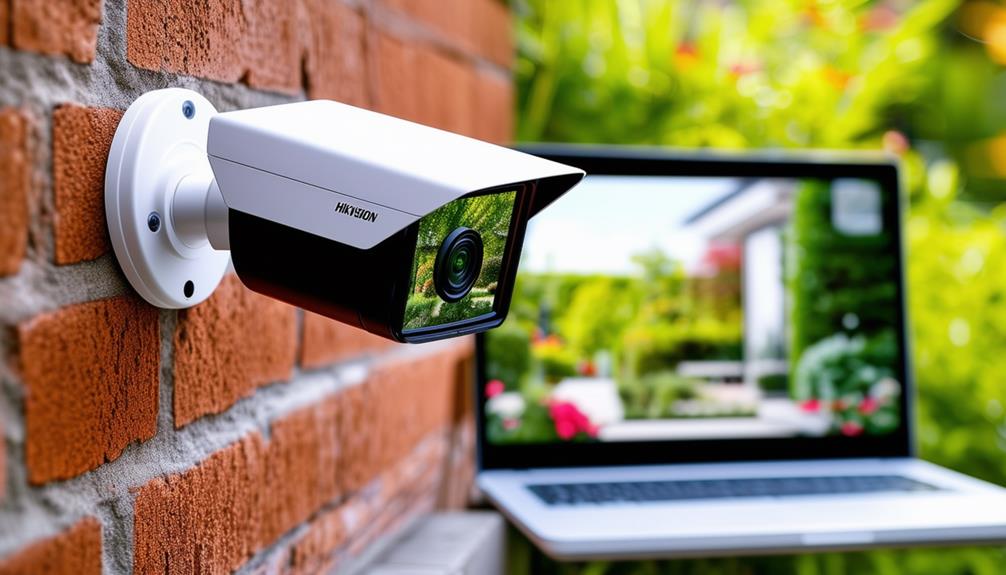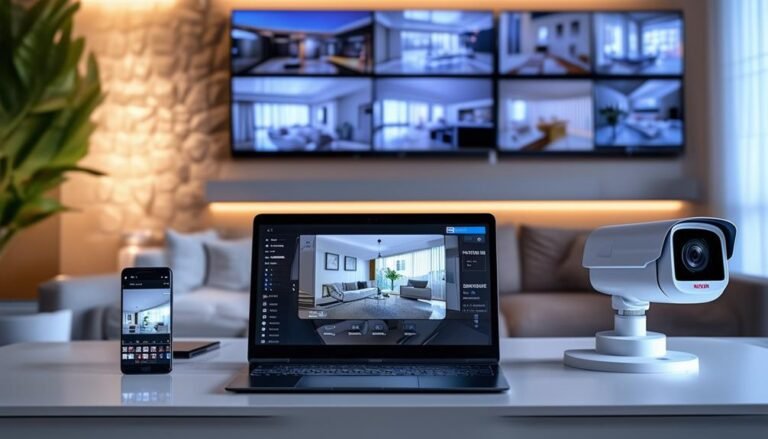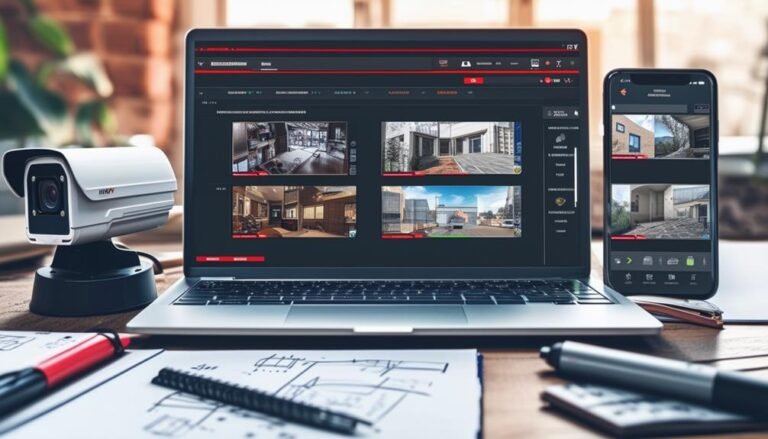Yes, you can use Hikvision cameras without an NVR. This setup allows your cameras to operate independently, thanks to features like MicroSD card slots for direct recording and Wi-Fi access for remote monitoring. However, you'll miss out on centralized management, advanced features, and efficient footage storage. While it's convenient, be aware that you might encounter limitations, such as reduced video quality and potential gaps in recording. If you're curious about optimizing your Hikvision setup or exploring alternative methods, there's more to discover that could enhance your surveillance experience.
Overview of Hikvision Cameras
Hikvision cameras are popular choices for both residential and commercial surveillance due to their advanced features and reliability. If you're looking to enhance your security, these cameras offer a range of options tailored to different needs. They come in various models, including bullet, dome, and PTZ (pan-tilt-zoom), allowing you to select the right style for your environment.
One of the key advantages of Hikvision cameras is their high-resolution capabilities. You'll find models supporting 4MP, 8MP, and even higher resolutions, ensuring that you capture clear images even in challenging lighting conditions. Plus, many of these cameras are equipped with night vision technology, so you can monitor your property around the clock without sacrificing quality.
Another significant feature is the built-in motion detection. This means you won't have to sift through hours of footage. Instead, you'll receive alerts only when something happens, giving you the freedom to focus on what matters most.
Hikvision cameras also support various connectivity options. Whether you prefer wired or wireless setups, there's a solution for you. This flexibility allows for easier installation and integration into your existing security system.
What Is an NVR?
An NVR, or Network Video Recorder, is an essential component in modern surveillance systems, allowing you to manage and store video footage from multiple cameras. There are various types of NVR systems available, each designed to meet different needs and preferences. Understanding the benefits of using an NVR can help you decide if it's the right choice for your Hikvision camera setup.
NVR Definition and Purpose
Understanding the role of a Network Video Recorder (NVR) is essential for anyone looking to enhance their surveillance setup. An NVR is a device that manages and stores video footage from IP cameras, allowing you to monitor your environment efficiently. It simplifies video management, giving you greater control and flexibility over your security system.
Here are some key purposes of an NVR:
- Centralized Storage: It collects and stores video from multiple cameras in one location.
- Remote Access: You can view live feeds and recorded footage from anywhere via the internet.
- Motion Detection: Many NVRs include features that alert you when motion is detected.
- User Management: You can set permissions for different users, ensuring only authorized access.
- Scalability: As your needs grow, you can easily add more cameras without overhauling your system.
Using an NVR allows you to run an extensive surveillance system that fits your needs. While it's possible to operate a Hikvision camera without an NVR, having one can greatly enhance your overall experience, providing the freedom to monitor your property effectively.
Types of NVR Systems
When considering surveillance solutions, it's important to know that not all NVR systems are created equal. You'll find several types that cater to different needs and preferences. The most common are standalone NVRs, which operate independently and are ideal if you want a simple setup. They connect directly to your IP cameras over the network, allowing for centralized recording and playback.
Another option is a PC-based NVR, which uses software installed on a computer. This type offers more flexibility and can support advanced features, making it great for those who enjoy customizing their systems. If you're looking for something more integrated, you might consider an NVR that's built into a camera system. These all-in-one solutions simplify installation and reduce the need for extra hardware.
Lastly, there's cloud-based NVR, where your footage is stored online. This option can be appealing for those who prioritize remote access and don't want to manage physical storage. Each type has its pros and cons, so think about your specific needs and how much control you want over your surveillance setup. Ultimately, it's about finding the right balance between functionality and freedom.
Benefits of Using NVR
Why consider using a Network Video Recorder (NVR) for your surveillance needs? An NVR can greatly enhance your security system's efficiency and flexibility. With the right setup, you'll find that managing your surveillance footage becomes a breeze. Here are some benefits of using an NVR:
- Centralized Management: Control multiple cameras from one interface, making it easier to monitor your property.
- Enhanced Storage Options: NVRs usually support larger hard drives, allowing you to store more footage for longer periods.
- Remote Access: View your camera feeds anytime, anywhere, keeping you connected to your security.
- Higher Quality: Enjoy superior video quality and resolution, providing clearer images for better identification.
- Motion Detection Alerts: Receive notifications when movement is detected, ensuring you're always aware of potential security breaches.
Using an NVR not only simplifies your surveillance setup but also empowers you with the tools to protect your space. So, if you value autonomy and want to stay informed about what's happening around you, investing in an NVR is a smart move. Embrace the freedom to monitor your home or business with confidence!
Benefits of Using an NVR
When you use an NVR, you get centralized video management that makes monitoring a breeze. Plus, it offers enhanced storage capacity, allowing you to keep more footage without worrying about running out of space. These benefits can really streamline your surveillance setup and improve your overall experience.
Centralized Video Management
Centralized video management through a Network Video Recorder (NVR) offers multiple advantages for those looking to streamline their surveillance systems. When you use an NVR, you're not just connecting your cameras; you're creating a cohesive unit that simplifies monitoring and management. Here's why centralized video management can liberate your surveillance efforts:
- Easier Access: You can view all your camera feeds from a single interface, making it simple to monitor multiple locations.
- Remote Viewing: With an NVR, you can access live video feeds or recorded footage from anywhere, giving you control on the go.
- User-Friendly Interface: Most NVRs come with intuitive software that makes it easy to navigate and manage your recordings.
- Centralized Settings: You can configure settings for all your cameras in one place, saving you time and hassle.
- Efficient Search: Quickly find specific footage using time or event-based search functions, enhancing your ability to respond to incidents.
With centralized video management, you can enjoy a more organized, efficient, and effective surveillance system that gives you the freedom to focus on what matters most.
Enhanced Storage Capacity
Maximizing storage capacity is one of the key benefits of using an NVR in your surveillance setup. With an NVR, you can easily manage and store video footage from multiple Hikvision cameras, maximizing your overall storage potential. Unlike standalone cameras, which often have limited onboard storage, an NVR allows you to connect external hard drives or network storage devices, giving you the freedom to choose how much space you need.
This flexibility means you can store weeks or even months of footage without worrying about running out of space. Plus, you can set up automatic overwriting of older files, ensuring you always have the most recent footage available while still keeping essential recordings.
Using an NVR also enables you to customize your storage settings. You can adjust the quality and compression of the recorded video, ensuring you find the right balance between quality and capacity. This way, you're not just capturing what you need, but you're doing it efficiently.
In short, an NVR empowers you to enhance your surveillance storage capabilities, giving you the freedom to monitor your property without constraints.
Can You Use Hikvision Cameras Alone?
Hikvision cameras can function independently without a Network Video Recorder (NVR), making them a versatile choice for various surveillance needs. You can easily set up these cameras to operate on their own, providing you with the freedom to monitor your space without the confines of additional equipment. This independence allows you to utilize your Hikvision cameras in a way that best suits your situation, whether it's for home security or business surveillance.
When using Hikvision cameras alone, consider these options to maximize their effectiveness:
- MicroSD Card Storage: Many Hikvision cameras come with a slot for a MicroSD card, allowing you to record footage directly onto the card.
- Remote Access: You can connect your cameras to your Wi-Fi network, giving you the ability to view the live feed or recorded footage from anywhere using a smartphone or computer.
- Motion Detection Alerts: Set up motion detection alerts to receive notifications when activity is detected, keeping you informed without constant monitoring.
- Standalone Functionality: Use the camera's built-in features, such as scheduled recordings or continuous monitoring, to tailor your surveillance to your needs.
- Easy Setup: With user-friendly interfaces, you can quickly install and configure your cameras without needing extensive technical knowledge.
Alternative Recording Methods
While using Hikvision cameras independently offers great flexibility, exploring alternative recording methods can enhance your surveillance setup even further. You don't have to rely solely on a network video recorder (NVR) to capture and store footage. Instead, consider using microSD cards. Many Hikvision cameras come with a slot for these cards, allowing you to record directly on the camera itself. This method gives you the freedom to manage storage without needing additional hardware.
Another option you might find useful is cloud storage. Some Hikvision models support cloud services, enabling you to upload recordings online. This not only provides an off-site backup but also allows you to access your footage from anywhere. It's a great way to guarantee your data's safety, especially if you're concerned about theft or damage.
You can also explore using a computer-based software solution. Programs like iSpy or Blue Iris can connect to your Hikvision camera over your local network, letting you record and manage footage directly from your PC. This route gives you flexibility and the ability to customize your recording settings to suit your needs.
Lastly, consider integrating a home automation system. With the right setup, you can have your Hikvision camera trigger recordings based on events or schedules you create. This level of control means you can tailor your surveillance to fit your lifestyle, guaranteeing it meets your personal security needs without feeling constrained.
Direct Connection Options
When setting up your Hikvision camera without an NVR, you've got some direct connection options to evaluate. You can use an Ethernet cable for a stable connection, access Wi-Fi directly for flexibility, or configure it through a mobile app for convenience. Each method has its benefits, so let's explore them further.
Ethernet Cable Connection
If you're looking to connect your Hikvision camera directly without the need for an NVR, using an Ethernet cable is a simple and effective solution. This method not only provides a reliable connection but also gives you more control over your surveillance setup. Here's what you'll need to keep in mind for a successful direct Ethernet connection:
- Ethernet Cable: Verify you have a high-quality Ethernet cable for peak performance.
- Power Source: Confirm that your camera has access to power, either through PoE (Power over Ethernet) or a separate power supply.
- IP Address Configuration: Set up the camera's IP address to prevent conflicts with other devices on your network.
- Device Compatibility: Make sure your computer or device can access the camera's interface.
- Software Installation: Download the necessary software from Hikvision's website to manage your camera settings.
With this setup, you'll enjoy the freedom to monitor your surroundings without the added complexity of an NVR. Plus, it's a straightforward way to keep an eye on what matters most to you!
Wi-Fi Direct Access
For those who prefer a wireless setup, accessing your Hikvision camera via Wi-Fi is a convenient option. With Wi-Fi Direct Access, you can connect your camera directly to your smartphone or tablet without needing a network router. This method grants you more flexibility, allowing you to position your camera wherever you want without the constraints of cables.
To set this up, simply enable the Wi-Fi Direct feature on your camera. You'll find the option in the camera settings. Once activated, your camera will create its own Wi-Fi network. You can then connect your device to this network, giving you instant access to the live feed and camera settings.
This direct connection is especially beneficial for on-the-go monitoring. You won't have to rely on a traditional NVR setup or a complicated network configuration. Just remember, the range might be limited compared to typical Wi-Fi networks, so stay within close proximity for peak performance.
Mobile App Configuration
To effectively configure your Hikvision camera using a mobile app, start by ensuring that your device is connected to the camera's Wi-Fi network. Once you're connected, you'll have the freedom to manage your camera straight from your smartphone. Here's a quick guide to get you going:
- Download the App: Get the Hik-Connect or iVMS-4500 app from your app store.
- Add Your Camera: Open the app, select "Add Device," and choose "Wi-Fi" for direct connection.
- Scan the QR Code: Point your camera at the QR code displayed on your phone for seamless pairing.
- Adjust Settings: Customize your settings like resolution, motion detection, and alerts to fit your needs.
- View Live Feed: Start monitoring your camera's live feed right from your mobile device.
With these steps, you're free to manage and control your Hikvision camera without the need for an NVR. Enjoy the convenience of surveillance right at your fingertips!
Impact on Video Quality
When using a Hikvision camera without an NVR, you might notice variations in video quality that can substantially impact your surveillance experience. Without the centralized processing power of a Network Video Recorder, the camera's video stream relies solely on its internal capabilities. This means you're likely to encounter limitations in resolution, frame rates, and overall image clarity.
One of the first things you'll see is a potential drop in resolution. While Hikvision cameras are capable of capturing high-definition video, streaming directly to a local device may compress the feed, leading to lower image quality. This becomes particularly problematic in vital situations where you need clear details, like identifying a suspect or reading a license plate.
Frame rates can also suffer. When you're not using an NVR, the camera may not deliver smooth playback due to bandwidth constraints or processing limitations. This choppiness can make it difficult to follow fast-moving objects or capture essential moments in real-time.
Moreover, if you're capturing video onto a local storage device, you're limited by its capacity and speed. A slower write speed might result in dropped frames or even complete loss of footage, which can be incredibly frustrating when you want to review your recordings.
In essence, while using a Hikvision camera without an NVR offers flexibility, it often compromises video quality, making it important to weigh your options if high-quality surveillance is a priority.
Remote Access Without NVR
How can you access your Hikvision camera remotely without an NVR? It's easier than you might think! With the right setup, you can enjoy the freedom of monitoring your space anytime, anywhere. Here's what you need to do to get started:
- Connect your camera to the internet: Make sure your Hikvision camera is connected to your Wi-Fi network or directly to your router using an Ethernet cable.
- Use the Hik-Connect app: Download the Hik-Connect app on your smartphone or tablet. This app allows you to access your camera remotely.
- Register and link your device: Create an account on the Hik-Connect app and add your camera by entering its Serial Number and Activation Code.
- Configure your camera settings: Adjust the camera settings through the app to optimize your viewing experience. You can set up notifications for motion detection, too!
- Access live view and recordings: Once everything's set, you can view live streams and recorded footage directly from your device, giving you peace of mind wherever you are.
Limitations of Not Using NVR
While accessing your Hikvision camera without an NVR offers flexibility, it does come with certain limitations. First off, without an NVR, you won't have a centralized system for managing multiple cameras. If you're monitoring several cameras, switching between their feeds can become cumbersome. You might find yourself juggling multiple apps or browser tabs, which isn't the most efficient way to keep an eye on things.
Additionally, recording options can be restricted. Most NVRs provide extensive storage capabilities, enabling continuous or scheduled recording. Without one, you're often limited to local storage on the camera itself or using cloud services, which might not meet your needs if you're looking for long-term storage or significant backup options. This can lead to gaps in your footage, especially if the storage fills up.
Another limitation is in the area of advanced features. NVRs often support features like motion detection, alerts, and remote access to recordings, making monitoring easier. Without an NVR, you may miss out on these functionalities, meaning you might have to manually check your camera feeds more frequently.
Choosing the Right Setup
Managing the limitations of not using an NVR opens up the need to carefully consider your camera setup. You want to guarantee your Hikvision camera meets your specific needs while maximizing its potential. Here's what to keep in mind as you make your choices:
- Camera Type: Decide whether you need a fixed lens or a varifocal lens for flexibility in adjusting the field of view.
- Storage Solution: Consider using an SD card for local storage, but check the capacity and recording time to verify it aligns with your requirements.
- Power Supply: Think about how you'll power your camera, whether through PoE (Power over Ethernet) or a standard power adapter, to ascertain uninterrupted operation.
- Network Connectivity: Confirm your camera has a reliable Wi-Fi connection or use Ethernet for a more stable setup if you're in a larger area.
- Software Compatibility: Look for software that supports remote access and monitoring, allowing you to view footage without the constraints of an NVR.
Frequently Asked Questions
Can I Connect Multiple Hikvision Cameras Without an NVR?
Yes, you can connect multiple Hikvision cameras without an NVR. You'll need to set them up individually on your network, using a computer or a standalone device like a DVR. Just verify each camera's IP address is unique to avoid conflicts. This setup gives you the freedom to manage your cameras independently, but keep in mind that you won't have centralized recording or management features that an NVR would provide.
Do Hikvision Cameras Support Cloud Storage Options?
Yes, Hikvision cameras do support cloud storage options, giving you the flexibility to store your footage securely online. You can easily set this up through the Hik-Connect app, which allows you to access and manage your recordings from anywhere. This way, you won't have to rely solely on local storage, ensuring you have peace of mind. Just remember to check your internet connection and subscription plans for ideal use.
What Power Supply Do Hikvision Cameras Require?
Hikvision cameras typically require a power supply of 12V DC, but it's crucial to check the specific model you're using. Many of these cameras can also be powered via PoE (Power over Ethernet), which simplifies installation by using the same cable for data and power. Just make sure your network switch or injector supports PoE if you choose that route. Always prioritize using the right specifications for ideal performance and longevity.
Are Hikvision Cameras Compatible With Third-Party Recording Software?
Yes, Hikvision cameras can work with third-party recording software, giving you flexibility in how you manage your surveillance. You'll need to verify that the software you choose supports the camera's protocols, like ONVIF. This compatibility allows you to set up your system according to your preferences, enhancing your control over monitoring. Just remember to check the specific software features to make sure it meets your unique needs for security management.
How Do I Troubleshoot a Hikvision Camera Not Connecting Directly?
When you're stuck with a Hikvision camera that won't connect, it can feel like you're chasing your tail. First, double-check your network settings; verify the camera's IP address matches your network. Restart both the camera and router, as a fresh start often clears up issues. If that doesn't work, try connecting via a different cable or port. A little patience can go a long way in troubleshooting tech hiccups!



